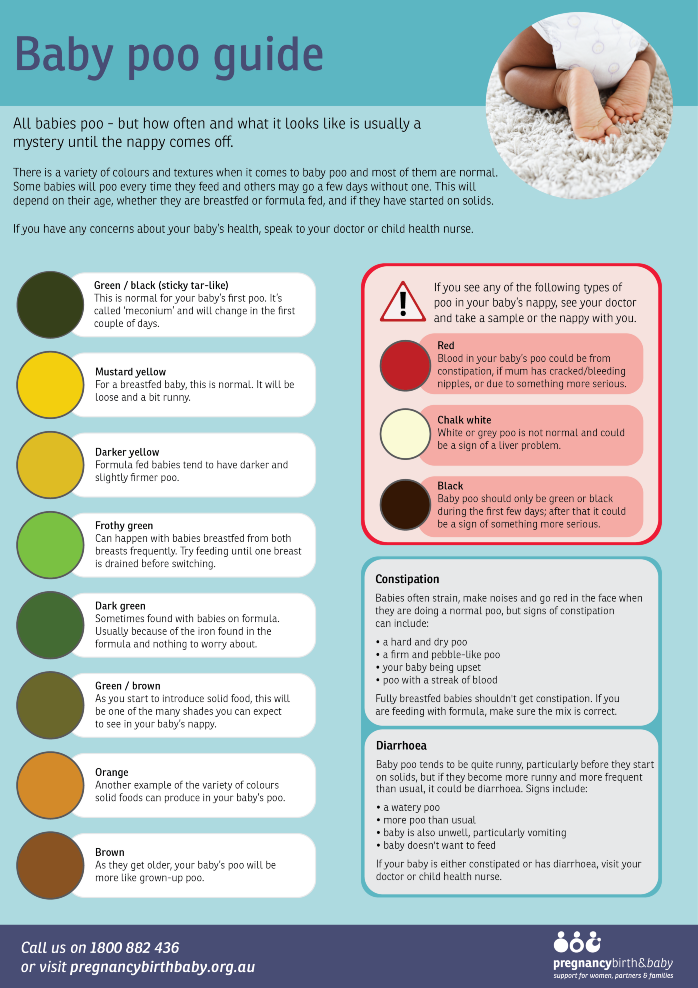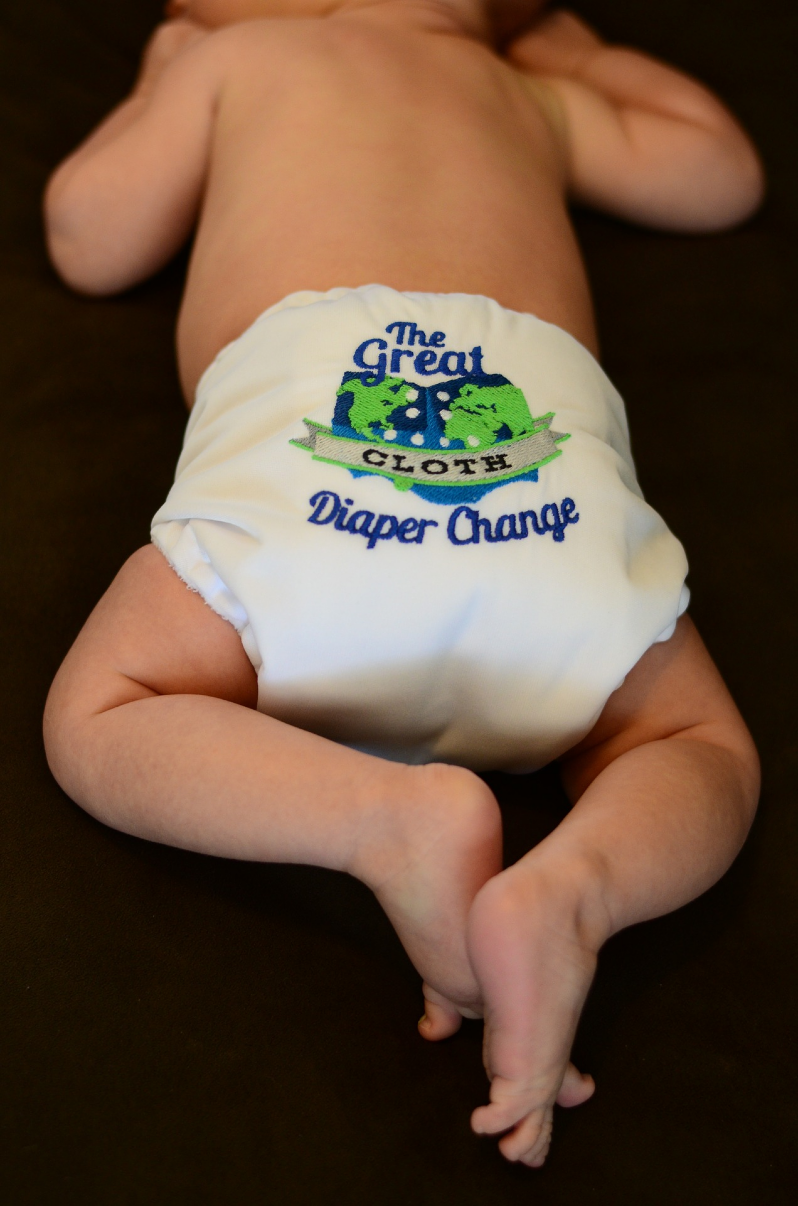
You’ll probably never care about (or talk about) poop as much as you will when you’re a new parent. From color to texture to odor, you might find yourself sometimes wondering, “Is this normal?” That’s a good thing! “The extra attention to stool is very well-deserved,” says Laura Jana, MD, co-author of Heading Home with Your Newborn: From Birth to Reality. “Your baby’s poop tells a whole lot about how he or she is doing with eating.”
So get over any squeamishness you might have and check out this important baby poop info.
What it is: Meconium
When: Within the 24 hours after birth
What you need to know: You’ve probably never seen something as sticky, thick, tar-like and greenish-black as your child’s first poop. Meconium is “what’s been sitting inside the intestines while the baby is forming,” says L.E. Wolovits, MD, a general pediatrician at Children’s Medical Center in Dallas and an assistant professor of Pediatrics at UT Southwestern Medical School. It is a combination of amniotic fluid, mucus, and miscellaneous cells that were shed during the baby’s development. It’s also VERY messy and sticky! Expect to be cleaning up a meconium mess for at least a little while. The good news? The meconium stage only lasts a few days.
What it is: Transitional stool
When: Days 1- 5 (or so)
What you need to know: Over the first few days of life outside the womb, you’ll notice your baby’s poop changing from the tarry meconium to something lighter colored and not quite so sticky. Their poop may even look completely different from one diaper to the next. It takes time for your baby to empty out their pre-natal waste. In the meantime, they’re starting to take in fluids — colostrum and breastmilk (or formula). New food in = old poo out. How quickly your baby passes through this stage depends completely on how much they take in. If they nurse a lot and your milk comes in on day two, the transitional poop stage may only last a day or so. If it takes them longer to gain their appetite, the transitional stage could last until the end of the first week.
What it is: Breast milk poo
When: As long as your baby is exclusively breastfed
What you need to know: “The best description I ever heard of breastfed stool is that it’s like mustard being shot out of a cannon,” says Dr. Wolovits. Breast milk poop can indeed be that yellow. And it can definitely come with some force behind it! Almost every veteran parent has a story of being hit by projectile poop, so take our advice: have a new diaper ready to go as soon as you remove the soiled one. It can help to slide the new diaper underneath before removing the old one, too. Breast milk poop is yellowish-green and seedy. It’s not formed (meaning it’s fairly runny) — but it’s not exactly liquid either. The color and consistency may change slightly from day to day, but in general, it’s squishy, yellow-hued and fairly non-offensive. Chalk it up as another benefit of breastfeeding: breast milk poo doesn’t stink like formula poo does. In fact, it has a unique smell that’s sometime described as sweet or yeasty.
What it is: More dirty diapers in one day than you can possibly imagine
When: Early newborn period
What you need to know: Super frequent pooping is 100 percent normal! Some babies, especially breastfed newborns, “squirt every time they eat,” says Dr. Jana. That’s because babies, like adults, have a gastrocolic reflex. This just means that the act of eating triggers intestinal activity — which, in turn, triggers the need to poop. But don’t worry: as your baby gets older, they’re better able to hold their poop. Things will slow down around month two and you won’t be changing 20 diapers a day.
What it is: Formula poop
When: As soon as formula feeding is established
What you need to know: Formula fed babies usually have soft, tan poops. (Some people describe it as like peanut butter – gross, we know!) Don’t even try to compare your baby’s formula fed poops to the poops of a breastfed baby. Your baby’s stools will be more solid (but still mushy) and definitely more smelly.
What it is: Frothy green poop
When: Rare
What you need to know: Green, frothy stools are often a sign of a foremilk/hindmilk imbalance in a breastfed baby, so if you see foamy green poo, call your pediatrician or lactation consultant. Foremilk, the first milk you baby gets during a feeding, is thin and watery. Hindmilk is thicker (think of milk with cream) and contains far more fat and calories. Green frothy poop is typically the result of too much foremilk (and not enough hindmilk). Letting your baby decide when to stop feeding (instead of switching them after a pre-determined time) may resolve this problem.
What it is: Could be blood — or nothing
When: Rare
What you need to know: A little bit of blood in your baby’s poop, especially if the stool seems harder than usual, is typically no big deal. “If your baby is acting completely fine and eating okay, you can probably wait to call the doctor,” says Dr. Wolovits. (Of course, you should always call a pediatrician near you if you’re concerned.) If the blood is mixed with the stool, however, call your pediatrician as soon as possible — just to be on the safe side. If your baby is older and eating solids, think long and hard about what he’s had to eat recently before panicking at the sight of red-colored poop. Some foods (beets, for example) can turn their poop a lovely shade of magenta.
What it is: Chalky white poop
When: Extremely rare
What you need to know: White poop is not normal, so “if you see it, you need to say something,” Dr. Jana says. It may be a sign of undiagnosed liver disease that needs to be addressed as soon as possible by your pediatrician.
What it is: Black-tinged poop
When: Sometime after the meconium period
What you need to know: If your baby’s poops have been normal colored (yellowish-green for breastfed babies, tan for formula-fed babies) and suddenly transition to a dark black color, give your doc a call. That black color may be an indicator of bleeding somewhere in the digestive tract, Dr. Jana says. Typically, semi-disgested blood will come out black instead of red. One small caveat: iron supplements can turn the poop black as well, so if your baby has recently started an iron supplement a black poop may be normal.
What it is: Mucus-streaked poop
When: Most common when baby is teething or has a cold
What you need to know: “When babies are teething, they have increased drool and saliva and the stools may look a little more slimy or mucusy,” Dr. Wolovits says. Increased drool means more drool to swallow, which in turn (of course) means more drool in the diaper. This especially holds true when your baby has a cold. If they have mucus running down the back of their nose and throat, the odds are good that you’ll see it in their diaper. Sometimes mucus in the stool can indicate infection. In that case, the poop will have a funny odor and may be a different color. (Trust us: you’ll know.)
What it is: Solid food poop
When: After starting solids
What you need to know: Expect diaper duty to get decidedly stinkier after your baby starts solids. The poop will also change color and consistency. Watch out: rice cereal, in particular, can be constipating. If your baby is having trouble, you should consider switching to oatmeal baby cereal. Color-wise, expect a LOT of variation. Carrots tint the poop orange, blueberries turn it bluish-purple… you get the picture.
What it is: Poop with undigested bits of food
When: After starting “real food”
What you need to know: It’s not uncommon — or a sign of trouble — to find whole pieces of food in your older baby’s poop. “When you change the diaper, you may actually see corn and raisins and bizarre chunks of food,” Dr. Wolovits says. That’s partly because your baby doesn’t have many teeth. It’s pretty hard to chew your food thoroughly when you don’t have the necessary equipment!
What it is: Loose, watery poop (diarrhea)
When: Usually the result of a bacterial (or viral) infection
What you need to know: If it’s winter and your baby has a slight fever and green, really smelly, really watery poop, he probably has rotavirus — the most common cause of severe diarrhea in babies. Food allergies, antibiotics, parasites and other infections can also cause diarrhea, so if your baby has had diarrhea for more than a day or so, call your local pediatrician! Dehydration is a real threat! Make sure you are trying to push the fluids if at all possible. If your baby develops a rash, feel free to apply a liberal amount of diaper cream to soothe their sore bottom! Chafing and broken skin in this tender area can also lead to a secondary infection if gone untreated.
What it is: Hard, dry stools (and sometimes constipation)
When: On occasion. Starting solids may cause constipation.
What you need to know: The number of days between poops is not a reliable indicator of constipation. “Some babies can go a week without pooping and be fine,” Dr. Jana says. “Other babies are constipated after two days.” So instead of looking at the calendar with a furrowed brow, inspect your baby’s poops. If they’re soft, all is well. If they’re hard, formed, and dry (like little rabbit pellets), they’re probably constipated. Try switching cereals; rice cereal is more constipating than barley or oatmeal. You can also try adding fruits and veggies if you’ve already started solids. There’s no harm in giving your local pediatrician a call, either.
MacKoul Pediatrics is an amazing local pediatrics office in Cape Coral, FL where caring, compassionate doctors and nurses work with you to keep your children as healthy as possible. MacKoul cares for children from birth to college age, from Cape Coral, Fort Myers, Naples, and beyond.
January 9, 2015
 You’ll probably never care about (or talk about) poop as much as you will when you’re a new parent. From color to texture to odor, you might find yourself sometimes wondering, “Is this normal?” That’s a good thing! “The extra attention to stool is very well-deserved,” says Laura Jana, MD, co-author of Heading Home with Your Newborn: From Birth to Reality. “Your baby’s poop tells a whole lot about how he or she is doing with eating.”
You’ll probably never care about (or talk about) poop as much as you will when you’re a new parent. From color to texture to odor, you might find yourself sometimes wondering, “Is this normal?” That’s a good thing! “The extra attention to stool is very well-deserved,” says Laura Jana, MD, co-author of Heading Home with Your Newborn: From Birth to Reality. “Your baby’s poop tells a whole lot about how he or she is doing with eating.” 8.) White As A Ghost
8.) White As A Ghost